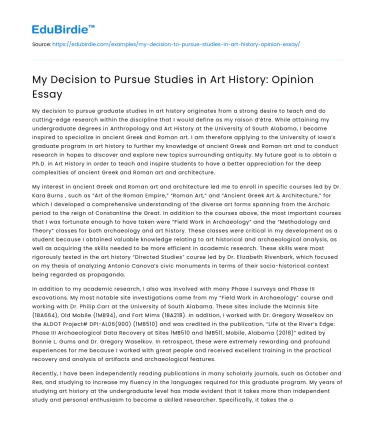My decision to pursue graduate studies in art history originates from a strong desire to teach and do cutting-edge research within the discipline that I would define as my raison d’être. While attaining my undergraduate degrees in Anthropology and Art History at the University of South Alabama, I became inspired to specialize in ancient Greek and Roman art. I am therefore applying to the University of Iowa’s graduate program in art history to further my knowledge of ancient Greek and Roman art and to conduct research in hopes to discover and explore new topics surrounding antiquity. My future goal is to obtain a Ph.D. in Art History in order to teach and inspire students to have a better appreciation for the deep complexities of ancient Greek and Roman art and architecture.
My interest in ancient Greek and Roman art and architecture led me to enroll in specific courses led by Dr. Kara Burns , such as “Art of the Roman Empire,” “Roman Art,” and “Ancient Greek Art & Architecture,” for which I developed a comprehensive understanding of the diverse art forms spanning from the Archaic period to the reign of Constantine the Great. In addition to the courses above, the most important courses that I was fortunate enough to have taken were “Field Work in Archaeology” and the “Methodology and Theory” classes for both archaeology and art history. These classes were critical in my development as a student because I obtained valuable knowledge relating to art historical and archaeological analysis, as well as acquiring the skills needed to be more efficient in academic research. These skills were most rigorously tested in the art history “Directed Studies” course led by Dr. Elizabeth Rivenbark, which focused on my thesis of analyzing Antonio Canova’s civic monuments in terms of their socio-historical context being regarded as propaganda.
In addition to my academic research, I also was involved with many Phase I surveys and Phase III excavations. My most notable site investigations came from my “Field Work in Archaeology” course and working with Dr. Philip Carr at the University of South Alabama. These sites include the McInnis Site (1BA664), Old Mobile (1MB94), and Fort Mims (1BA218). In addition, I worked with Dr. Gregory Waselkov on the ALDOT Project# DPI-AL06(900) (1MB510) and was credited in the publication, “Life at the River’s Edge: Phase III Archaeological Data Recovery at Sites 1MB510 and 1MB511, Mobile, Alabama (2018)” edited by Bonnie L. Gums and Dr. Gregory Waselkov. In retrospect, these were extremely rewarding and profound experiences for me because I worked with great people and received excellent training in the practical recovery and analysis of artifacts and archaeological features.
Recently, I have been independently reading publications in many scholarly journals, such as October and Res, and studying to increase my fluency in the languages required for this graduate program. My years of studying art history at the undergraduate level has made evident that it takes more than independent study and personal enthusiasm to become a skilled researcher. Specifically, it takes the above comment combined with a network made up of remarkable peers and colleagues to achieve success in any field of study. This is the environment that the University of Iowa’s graduate program in art history offers its students.






 Stuck on your essay?
Stuck on your essay?

